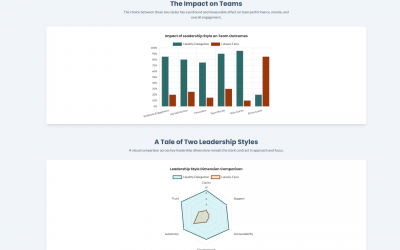“Treat a man as he is and he will remain as he is. Treat a man as he can and should be and he will become as he can and should be.” — Stephen R. Covey
As a leader, what is your default setting? When a deadline is missed or a project veers off course, is your first instinct to search for blame or for understanding? The quiet, often unconscious, assumption we hold about our team’s intentions and capabilities is one of the most powerful levers we have. Trust-based leadership, which begins with assuming positive intent, isn’t about naive optimism; it’s a strategic framework for creating a culture of accountability, psychological safety, and exceptional performance.
The Principle
At its core, trust-based leadership operates on the principle of assuming positive intent: defaulting to the belief that your team members are acting with the best interests of the organization at heart. It means that when faced with ambiguity, mistakes, or unexpected outcomes, you choose to believe they were driven by good intentions, a lack of information, or systemic constraints, rather than malice, laziness, or incompetence.
This mindset fundamentally reframes a leader’s role from that of a foreman, who directs and inspects, to that of a coach, who empowers and removes obstacles. It’s the difference between asking, “Why didn’t you do this right?” and asking, “What barriers did you run into, and how can we clear them together?” This approach doesn’t abdicate responsibility or ignore poor performance; rather, it changes the starting point of the conversation, making it more productive and less adversarial.
Why This Principle Matters
In today’s competitive landscape, the difference between a good company and a great one often comes down to one thing: its people. A leader’s belief in their team acts as a catalyst for engagement and discretionary effort. When employees feel trusted and respected, they are more likely to take ownership of their work, innovate, and go the extra mile. This feeling of trust is a core component of psychological safety—the shared belief that the team is safe for interpersonal risk-taking.
For business owners and executives, fostering this culture has a direct impact on the bottom line. Organizations with high levels of trust report higher productivity, better employee retention, and increased profitability. Conversely, a culture of suspicion breeds micromanagement, which stifles creativity, erodes morale, and leads to burnout and high turnover. By choosing to lead with trust, you are making a direct investment in the human capital that drives your organization’s success.
Why This Principle Works
This isn’t just a feel-good idea; it’s grounded in well-established psychological concepts. The most prominent is the Pygmalion Effect, also known as the Rosenthal Effect. This theory, validated by decades of research since the seminal 1968 study by Robert Rosenthal and Lenore Jacobson, demonstrates that our expectations of others can become self-fulfilling prophecies. When leaders genuinely expect their team members to be capable, competent, and motivated, they subconsciously alter their own behavior—providing more support, better feedback, and more challenging opportunities. In response, team members rise to meet these high expectations, leading to improved performance.
This principle also aligns with Attribution Theory, which explores how we explain the causes of behavior. Leaders who operate from a place of trust are more likely to make external attributions for failures (e.g., “The process was flawed,” or “The client changed the requirements”). This leads to problem-solving. In contrast, leaders who assume negative intent often make internal attributions (e.g., “They are not skilled enough,” or “They don’t care”), which leads to blame. By consciously choosing the former, leaders create an environment focused on continuous improvement rather than finger-pointing.
How This Principle Works: A Story
Consider Alex, the newly appointed Director of Operations at a mid-sized logistics company. He inherited a team that was known for being adequate but uninspired. His predecessor, a notorious micromanager, had a simple philosophy: “Trust, but verify… constantly.” The team’s performance was stagnant, and morale was visibly low.
One of Alex’s direct reports was a senior coordinator named Maria. Her performance reviews described her as “meeting expectations” but lacking initiative. During their first one-on-one, Alex didn’t grill her on performance metrics. Instead, he asked about her role, her challenges, and what she would change if she were in his shoes. He listened intently, assuming she had valuable insights.
A month later, a major shipping crisis erupted. A critical software system went down, threatening to delay hundreds of deliveries. The old protocol was for the director to take command, barking orders until the issue was resolved. Alex’s instinct, honed by years in a different culture, was to do the same. But he paused. He thought of Maria. During their talk, she had mentioned several potential fail-safes for the system that had been ignored.
He called Maria into his office. “Maria,” he said, “this is a mess, and we’re short on time. I remember you had some ideas about system redundancies. I believe you have the best understanding of the operational details here. I need you to lead the response team. I will run interference for you and get you any resources you need. What’s your plan?”
Maria was visibly stunned. No one had ever given her that level of autonomy, let alone during a crisis. For a moment, she hesitated. Then, fueled by the vote of confidence, she stepped up. She laid out a clear, three-point plan to manually reroute the most critical shipments while a sub-team worked on a software patch. She was decisive, organized, and confident.
Over the next eight hours, Maria didn’t just manage the crisis; she commanded it. She coordinated with IT, customer service, and the warehouse floor, communicating with a clarity no one had seen from her before. The team, seeing one of their own empowered, rallied behind her. By the end of the day, the vast majority of shipments were back on track, and a temporary fix was in place.
In the debrief, Alex publicly credited Maria for her leadership. He had chosen to lead with trust, believing in her potential rather than her track record, and in doing so, he hadn’t just solved a crisis. He had unlocked a leader.
Practical Strategies for Leaders
Adopting this principle requires conscious effort. Here are some actionable ways to start:
- Reframe Your Questions: Instead of asking “Why is this late?” try “What challenges are getting in the way of the deadline?”
- Delegate Ownership, Not Tasks: Grant team members autonomy over the outcome and let them determine the process. Express your confidence: “I’m giving this to you because I trust your judgment.”
- Seek to Understand First: When a mistake occurs, start with curiosity. Use phrases like, “Walk me through your thought process here.” This gathers information before jumping to conclusions.
- Acknowledge and Appreciate Intent: Even if an initiative doesn’t succeed, recognize the effort and positive intent behind it. “I see what you were trying to accomplish here, and I appreciate you taking the initiative. Let’s talk about what we learned.”
- Separate the Person from the Problem: Focus feedback and problem-solving on the action or the situation, not on the individual’s character or competence.
Critical Reflection
Take a moment to reflect on your own leadership style with these questions:
- What is my immediate, gut reaction when a team member makes a mistake?
- Think of a recent team failure. Did my language focus on blame or on solutions?
- Is there someone on my team whom I might be holding back because of my own low expectations?
- How do I create opportunities for my team members to demonstrate their full capabilities?
- Does my team feel safe bringing me bad news or admitting to a mistake? How do I know?
How to Begin Applying the Principle
Here is a small exercise to get you started this week:
The One-Week Trust Delegation:
- Identify: Choose one team member, perhaps someone you feel is underutilized or you have reservations about.
- Delegate: Find one meaningful, slightly challenging task or decision that you would normally handle yourself.
- Communicate: Delegate the task and explicitly state your confidence in them. For example: “I’d like you to take the lead on this. I trust your ability to see it through and am here to support you if you need me.”
- Step Back: Resist the urge to micromanage. Let them own it. Be available for questions but don’t hover.
- Reflect: At the end of the week, journal about the experience. What was the outcome? What did you learn about the team member? How did it feel to let go?
Wrap Up
Choosing to lead with trust is more than a management tactic; it is a leadership philosophy. It is the fulcrum upon which high-performing cultures are built. By assuming positive intent, you trigger the powerful Pygmalion Effect, cultivate deep-seated psychological safety, and transform your role from a director of tasks to a developer of people. This shift doesn’t just improve metrics and outcomes; it builds a resilient, innovative, and deeply engaged team that is capable of achieving the extraordinary.
Next Steps
For those interested in exploring this topic further, I recommend the following resources:
- Book: The Fearless Organization by Amy C. Edmondson. A brilliant deep-dive into the concept of psychological safety and how to build it.
- Book: Multipliers: How the Best Leaders Make Everyone Smarter by Liz Wiseman. This book provides a powerful framework for understanding how some leaders amplify their team’s intelligence and capability.
- Article: “Pygmalion in Management” (Harvard Business Review, J. Sterling Livingston). A classic article that remains profoundly relevant.



